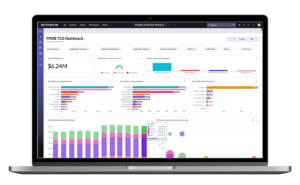The beginning of every IT financial management (ITFM) journey starts with a single question:
How much does our organization spend on IT?
As companies try to get their arms around the answer, their search often leads them to technology business management (TBM).
However, while TBM may be sufficient as a starting point, most organizations eventually outgrow it. Ultimately, it comes down to the inherent limitations of TBM, and a recognition that the TBM methodology doesn’t work for every company’s goals, strategies, and needs.
Below, we examine the critical difference between TBM and ITFM, and four signs that suggest it’s time to make the shift from TBM to ITFM.
Download a free eBook on Dispelling the 8 Biggest ITFM & TBM Misconceptions
TBM vs. ITFM: Understanding the Difference
At their core, both TBM and ITFM are about understanding where IT dollars are spent. Where they differ is that TBM was created by Apptio to drive awareness and education around that vendor’s particular approach to tracking and managing IT spend.
As such, TBM outlines a specific taxonomy and methods around activities like cost allocation, planning, and cost modeling. ITFM, on the other hand, is tool-agnostic, providing greater flexibility in how companies allocate costs and determine decision levers.
So, how do you know if you’ve outgrown TBM and are ready for ITFM? Let’s look at four key signs.
1. Stakeholders Don’t Recognize What You Show Them
The first pain point a lot of organizations feel when they have outgrown TBM relates to reporting. When numbers are reported out to the business based on TBM’s standardized view, people don’t necessarily see their footprint in that structure when you show results back.
That’s because not all IT costs fit neatly into TBM categories, and when they’re an important part of IT decision-making, you lose crucial detail when forced to group them with other costs.
The big problem here:
If stakeholders don’t recognize what they’re looking that, you won’t get to the level of decisioning that is your goal. This makes TBM adoption a challenge, reducing the traction you get from your TBM program overall.
2. The TBM Taxonomy Doesn’t Align with Your IT Delivery Model
The second big pain point that may indicate it’s time to move on to ITFM is when you need more flexibility in your cost modeling. The issue is that TBM’s rigid taxonomy means that it doesn’t always align with an organization’s IT delivery model, raising questions about the purpose of driving everyone to the same standardized taxonomy.
The truth is, it’s less about meeting companies’ needs and more about being able to make an apples-to-apples comparison of the IT footprint across all of Apptio’s customer base. In doing so, Apptio (now IBM) is better positioned to sell benchmarking services to its customers, since that’s only possible if everyone is reporting their data the same way.
3. Your Cost Model Isn’t Responsive
If the decisions you make with TBM don’t drive the results you’re looking for, this is a big sign that you’re ready to move on to ITFM.
When you put in a cost model, you need it to be responsive to the decisions you make in your organization. The typical journey for those standing up their first cost model using TBM goes something like this:
- When they see the first results come out, there’s a “high five moment” where people are excited to see their costs structured in a model.
- They use that cost model to have conversations and drive decisioning, often making difficult decisions such as turning off applications or realigning services.
- Months later, the numbers in the model don’t change because the decision levers weren’t structured to deliver the results they were trying to achieve.
Maybe they live with this disappointment for another 18 months, until three years into their journey, they start looking for a solution that actually gets the results they need.
4. Your Maturity Level Has Increased
Last but not least, a lot of companies naturally gravitate towards TBM when starting from square one. After they gain some level of maturity, however, they often realize that TBM’s one-size-fits-all taxonomy doesn’t actually fit at all.
That’s because while the TBM taxonomy may work for 80% of the business, it’s the last 20% of the model that needs to be tailored to how you communicate results out to the business. That’s where the real success in cost optimization, efficiency, and value lies, and where ITFM holds the key to success.
Download your free eBook on 6 Keys to a Winning ITFM Implementation for a roadmap to ITFM deployment success







